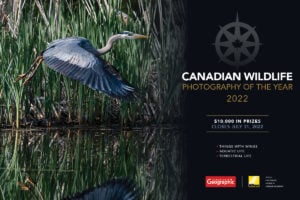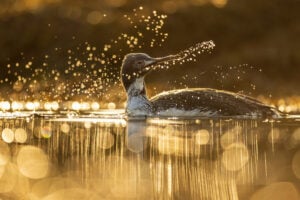
People & Culture
Enter the 2022 Canadian Wildlife Photography of the Year competition!
Submit your best wildlife photos for a chance to win cash prizes and see your work published in Canadian Geographic
- 500 words
- 2 minutes
Wildlife
Canadian Geographic is pleased to honour 14 photographers for their outstanding images of Canadian wildlife

A short-tailed weasel in its winter coat appears startled — or delighted — by something out of the frame. A robber fly immobilizes its prey by injecting it with paralyzing saliva. A garter snake prepares to forage for fish in the Salish Sea’s intertidal zone. The winning images of Canadian Geographic’s 2022 Canadian Wildlife Photography of the Year competition are a true reflection of this country’s biodiversity and the talents of our photographic community, showcasing amazing animals and rarely seen behaviours. For this 10th edition of our most popular photography competition, we are pleased to recognize one photographer who stood out among the nearly 10,000 entries: Brittany Crossman is our Canadian Wildlife Photographer of the Year and wins the grand prize of $5000.
Read on to learn more about Crossman and see the photos that most impressed our judges: wildlife photographers Mark Raycroft, Michelle Valberg and Jenny Wong and the editorial staff of Canadian Geographic.
Brittany Crossman

Brittany Crossman began her career as a wildlife photographer as a kid taking frog photos with a series of disposable cameras. Today, the 32-year-old resident of Riverview, N.B., has had her work published in multiple magazines, including Canadian Geographic, Canadian Wildlife and Saltscapes — and her intimate wildlife portraits have earned her a huge following on social media.
Living and working on the East Coast, Crossman has photographed black bears and beavers, gannets and grouse. But her favourite subject is the red fox, an animal for which she developed a special affinity through her work with the Canid Project, a wildlife rehabilitation and education non-profit organization.
“They’re very interesting animals, and when you photograph the same ones over a period of time, you get to see their different personalities,” she says. Crossman currently works as a substitute teacher, which frees up her time to take on photography projects and offer workshops throughout the school year — and allows her to share her images with young people. She recalls a proud moment when a student she taught in kindergarten decided in Grade 5 that she’d like to become a photographer: “She came up to me and said, ‘It’s because of you and your photos that I want to go into photography,’ and she showed me a bunch of photos of frogs she’d taken on her mother’s old cell phone. That’s how my passion for photography started, so that was really sweet.”
Although Crossman dreams of someday photographing megafauna like grizzly bears and wolves, she finds purpose in showcasing common animals and demonstrating that coexistence with urban wildlife is both possible and mutually beneficial.
“I hope when people look at my images, it sparks inspiration to make an effort to protect more natural places around Canada — and also that when they see wildlife in urban areas, they don’t go straight to wanting them eradicated or moved.”


Winner: Paul Baby
A short-tailed weasel seems to wear an expression of surprise and joy while peeking out from between fallen pine branches in Ottawa’s Britannia Conservation Area. Short-tailed weasels, also called ermine or stoats, are fleet-footed mustelids found in coniferous forests throughout mainland Canada.

Runner-up: Norrie Franko
Three moose emerge from the bush at dawn in Algonquin Provincial Park, Ont. The 7,600-square-kilometre park is one of the best places in Canada to see moose, particularly in the fall when males fight for mates.

Winner: Ryan Wilkes
A western terrestrial garter snake scouts for prey in an intertidal zone of the Salish Sea on Saturna Island, B.C. Although commonly thought of as land animals, coast-dwelling garter snakes in the Pacific Northwest are known to forage for saltwater fish in kelp beds and tide pools.

Runner-up: Callum Ramsay
A mallard duckling peeks out from underneath its mother’s wing on the banks of the Ottawa River. In spring, mallards lay up to a dozen eggs. Day-old ducklings are able to run, swim and forage for food — but still depend on their mother until they learn to fly about two months after hatching.

Winner: Rory Wills
A robber fly immobilizes a beetle by injecting it with paralyzing saliva. Also called assassin flies, members of the family Asilidae are aggressive predators that ambush other insects, sometimes in flight, stabbing them with their sharp proboscis and injecting a deadly cocktail of enzymes.

Runner-up: Lukas Miller
Two juvenile rufous hummingbirds snuggle close in their nest at Deas Island Regional Park, B.C. Rufous hummingbirds breed farther north than any other hummingbird species and are a common visitor at backyard feeders in B.C. in the spring and summer.

Josh DeLeenheer
A Roosevelt elk has tangled with a hammock in the small community of Youbou, B.C., and won. The photographer contacted the B.C. Conservation Officer Service about the elk’s predicament and was told they would monitor the situation to determine if the elk needed help. Objects caught in antlers can impede an animal’s mobility or ability to feed; but if the animal seems to be coping, it is left alone until the antlers are eventually shed in the winter.

Maggie Parisé
A red fox kit cuddles up to its mother on a spring day in Montreal. Fox kits are born blind, deaf and toothless. By four weeks, their eyes are open, their teeth have come in, and guard hairs have begun to grow, giving the young kits a fuzzy appearance.

Alex McKerracher
A metallic sweat bee gathers pollen from a flower in the arboretum at the University of Guelph, Ont. Sweat bees — so called because they are attracted to the salt content of human perspiration — are the world’s second-largest bee family and exhibit a range of traits and behaviours. Some species are solitary, while others, like the green metallic sweat bee common throughout southern Ontario, nest in the bee equivalent of condos, with a shared entrance and separate units for each female and her offspring.

Jean-Christophe Lemay
A lion’s mane jellyfish slowly drifts under the surface of the waters of the Gulf of St. Lawrence below Cap Bon Ami in Forillon National Park, Que. The lion’s mane jellyfish, one of the largest known species of jellyfish, is found in the cold waters of the north Atlantic, Pacific and Arctic oceans.

Randy Tremblay
A mountain goat shelters from the heat in a shady grove on a spring day in Jasper National Park, Alta. In spring and summer, mountain goats spend most of their time above the treeline but sometimes venture into valleys in search of salt licks.

Aaron Todd
A territorial trumpeter swan charges at a pair of mute swans that have swum too close to its nest in Luther Marsh Wildlife Management Area near Grand Valley, Ont. Trumpeter swans were once extirpated from Ontario but have made a comeback thanks to reintroduction and conservation programs.

Antal I. Kozma
An eastern tiger swallowtail butterfly probes a milkweed flower for nectar on the side of a rural road near Highgate, Ont. Not to be confused with the Canadian tiger swallowtail, the eastern tiger swallowtail is mainly found in the Carolinian forest zone, which, in Canada, encompasses southwestern Ontario as far north as Toronto.

Are you passionate about Canadian geography?
You can support Canadian Geographic in 3 ways:

People & Culture
Submit your best wildlife photos for a chance to win cash prizes and see your work published in Canadian Geographic

Wildlife
Canadian Geographic is pleased to honour 15 photographers for their outstanding images of Canadian wildlife

Wildlife
Wildlife photographers on the thrill of the chase — and the importance of setting ethical guidelines

Wildlife
An estimated annual $175-billion business, the illegal trade in wildlife is the world’s fourth-largest criminal enterprise. It stands to radically alter the animal kingdom.